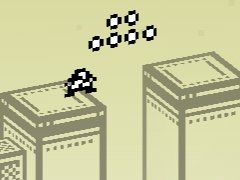Video Gamer is reader-supported. When you buy through links on our site, we may earn an affiliate commission. Prices subject to change. Learn more
Many games are influenced by Super Mario World, but 1-bit Ninja has its eyes on something else: 1989’s Super Mario Land on the Game Boy, a blissfully monochromatic platformer, recently re-released via the 3DS’ Virtual Console. 1-Bit Ninja is absolutely besotted with the old Super Mario Land series, and its love letter to Nintendo comes in the form of imitation lo-fi graphics, tricky stages, and even Mario’s iconic flag poles to end each of the game’s stages.
For a game so unwaveringly obsessed with how things used to be, it’s particularly odd that 1-bit Ninja’s sole direction is forward. There is simply no way to make the character go backwards, and changing your direction is only achievable by hitting springs along your route. Perhaps this is a concession on the part of the developer trying to cater for the iPhone’s touch screen, but all too often this turns the game into a brutally unforgiving string of frustrations. That coin you’ve missed by a couple of millimetres? Sorry, maybe next time.
It is odd how a game can emulate a classic so unashamedly and completely, and for the most part technically competently, and yet fail to achieve anywhere near the same level of quality as its inspiration. Where Super Mario Land was clever, new, and imaginative, 1-bit Ninja lives and dies entirely on nostalgia derived from the work overseen by Gunpei Yokoi and Nintendo some two decades ago.
When you overshoot the flag at the end of the second level, for instance, you get a Warp Zone allowing you to skip to later stages, and after finishing every world the game recycles a dull variant of an overly familiar cliché – that the princess (now a fourth wall device, dubbed the Game Toy) is in another castle.
Levels go for the same hard-for-the-sake-of-it challenge posed by titles such as Super Meat Boy, but 1-bit Ninja fails where Team Meat succeeded in its efforts to rejuvenate old-school design. There is simply not enough incentive to repeatedly run the gauntlets, and restarting from your myriad of failures is never as immediate as it needs to be.
The controls, while mostly sufficient, are rarely as precise as required, and often you’ll find yourself tapping your left and right thumbs in awkward spasm, progressing with staccato jerks rather than effortless hops and bounds. While 1-bit Ninja is never as directly challenging as the likes of Super Meat Boy or VVVVVV, checkpoints are non-existent and the prospect of playing through its dry levels multiple times is simply unpalatable.
The game’s genuine redeeming feature is tilting the camera into a 3D perspective to ferret out secret passages and shiny coins. It’s a new-school approach to the natural urge of pressing down on every pipe in the hope it warps you somewhere else.
1-bit Ninja’s appeal is immediate, and its visual style will easily curry favour with anybody that remembers growing up in the ’80s and early ’90s. Even two decades later, however, Super Mario Land vastly outshines this simple imitation.
